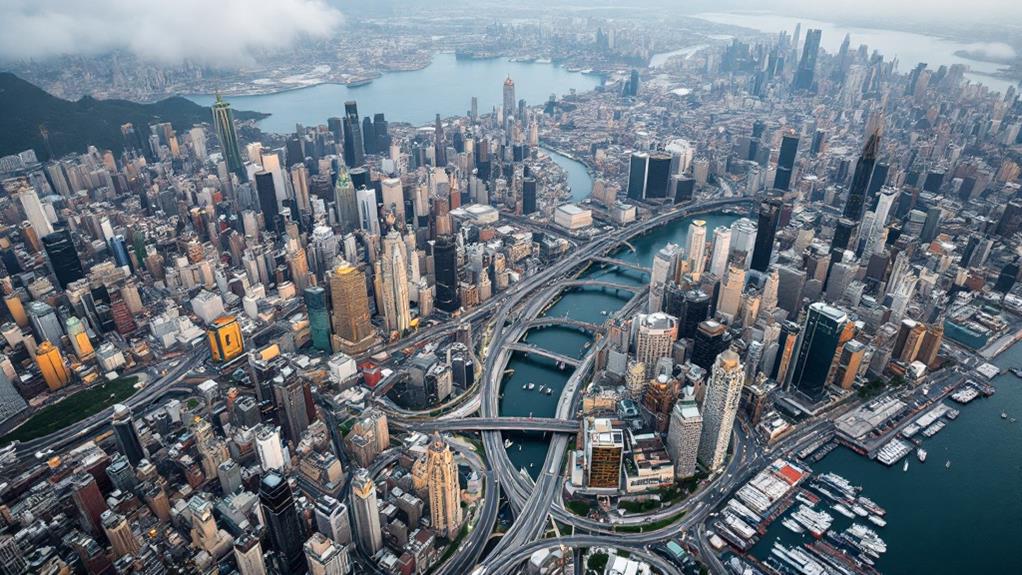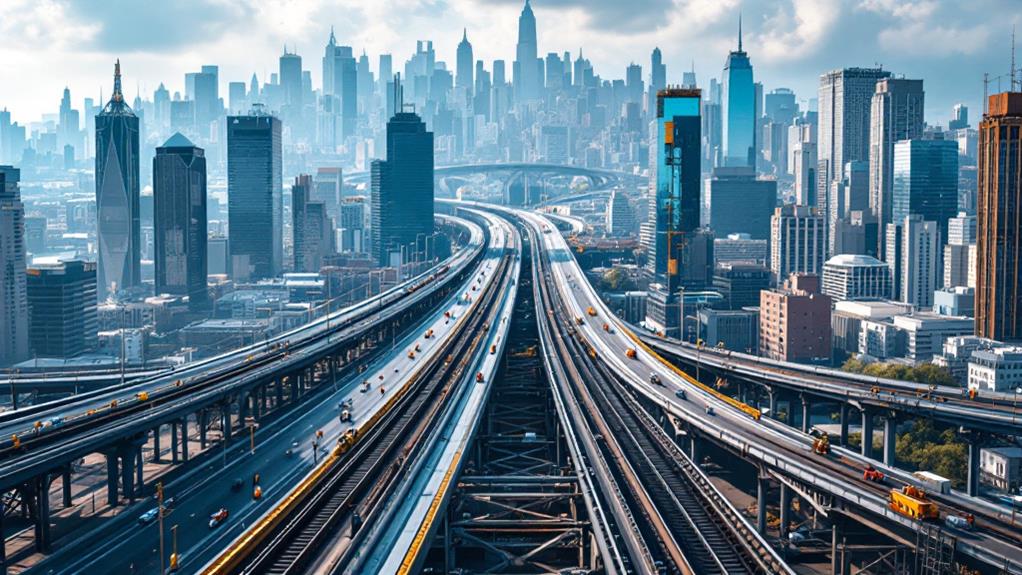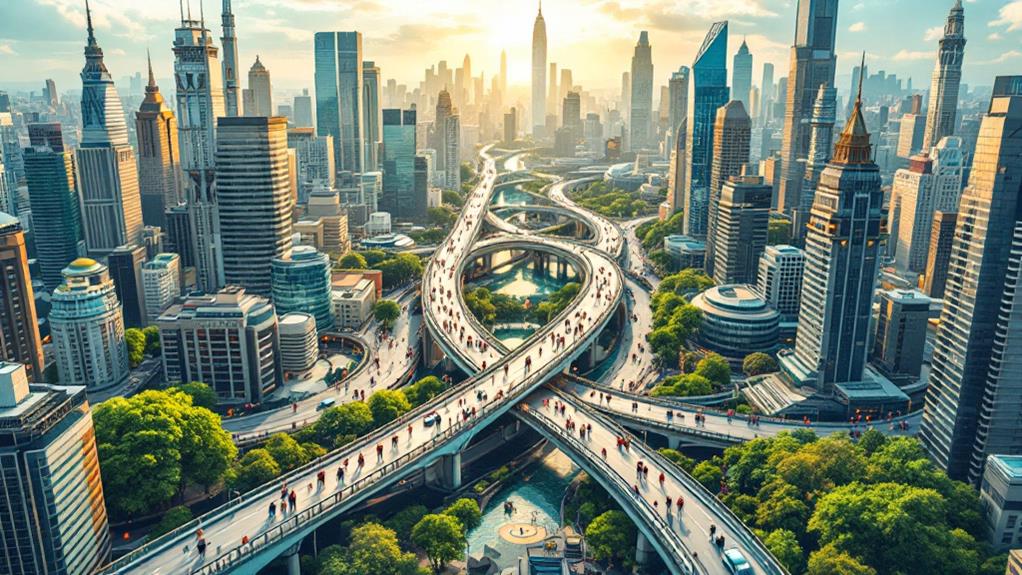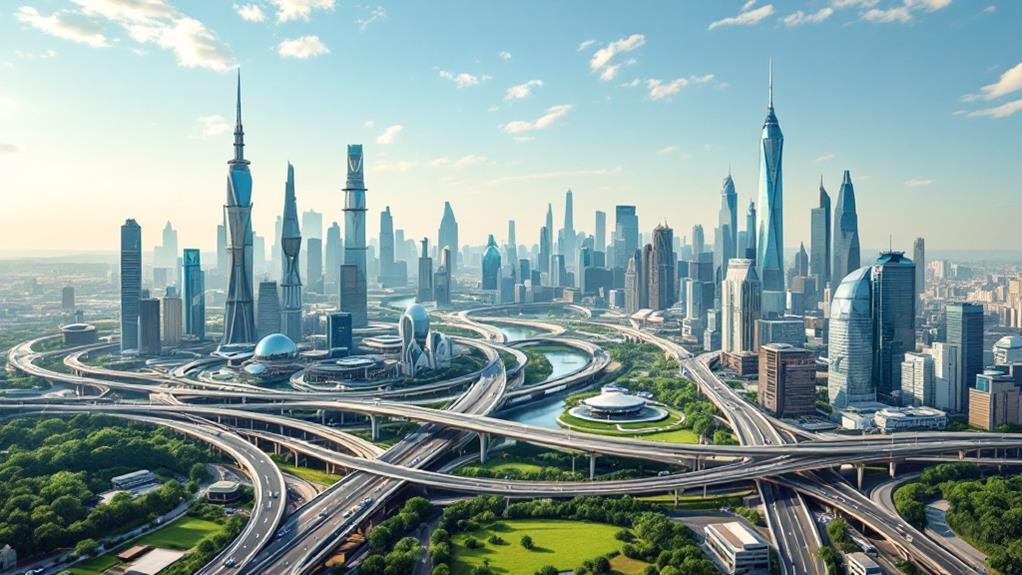How Infrastructure in the Largest Cities Supports Millions of People

In the largest cities, infrastructure is your backbone, seamlessly supporting millions with transport, utilities, and communications. Public transit systems reduce emissions and congestion, while broadband access fuels economic growth and bridge disparities. Strategic urban planning guarantees sustainable urban environments, adapting to the demands of demographics and climate change. Economic activities thrive thanks to infrastructure, attracting talent and businesses. It also mitigates power outages and guarantees equitable service distribution. Despite political and financial hurdles, public-private partnerships push development forward. Complex yet essential, urban infrastructure forms the core of thriving cities, and there's so much more to this intricate network.
Economic Role of Urban Infrastructure
In relation to economic growth, urban infrastructure plays an essential role by supporting the vast output that cities contribute to the global GDP. Cities generate over 80% of global GDP, and this staggering achievement hinges on robust urban infrastructure. Public transportation, telecommunications, and utility systems serve as the backbone of economic activity, ensuring that your city thrives and prospers. Infrastructure investment is significant; every 10% increase in public capital can elevate short-term economic growth by 0.8%.
However, when urban infrastructure falters, it can lead to substantial setbacks. For instance, traffic congestion in urban areas costs commuters nearly $160 billion annually. This emphasizes the importance of efficient public transportation systems to mitigate economic losses. Additionally, inadequate infrastructure, like limited broadband access, disproportionately affects lower-income communities, restricting their economic participation and widening income inequality.
On the brighter side, infrastructure spending not only reinforces economic growth but also creates jobs and stimulates local economies. Initiatives like the Bipartisan Infrastructure Law are set to channel vital funds into underserved areas, promoting economic equity. Moreover, effective urban infrastructure improves public health and helps combat climate change by fostering sustainable development.
Adapting to Demographic Shifts
Urban infrastructure is rapidly evolving to accommodate changing demographics and living preferences. With only 20% of U.S. households fitting the traditional suburban model now, cities need to adapt to varied living arrangements. This shift demands infrastructure that supports different household types and improves urban areas' functionality. You'll notice that local governments are responding by investing in public transit systems, as 55% of millennials favor living near accessible transit. This trend reflects a broader demographic shift away from car reliance, as fewer young people obtain driver's licenses.
Broadband access is also prioritized to stimulate economic growth and bridge disparities in urban areas. It's essential for cities to provide connectivity to support a diversified population, including poorer residents. As the population matures, infrastructure needs to adapt to guarantee equitable service distribution. Cities must consider accessibility and inclusivity when planning services and facilities for everyone. These changes highlight the importance of responsive infrastructure to support economic vibrancy and quality of life in the face of ongoing demographic shifts. As urban areas continue to grow, adapting infrastructure to these demographic changes guarantees sustainable development and thriving communities.
Addressing Infrastructure Vulnerabilities

Major urban areas face pressing infrastructure vulnerabilities that require prompt attention and action. You're aware that disasters like Hurricane Sandy have exposed how fragile urban infrastructure can be, especially regarding water and transportation systems. Cities struggle with a significant infrastructure deficit, highlighted by over 45,000 bridges in poor condition. This deficit impacts urban connectivity and safety, posing considerable risks to urban populations.
Traffic congestion is another pressing issue, costing commuters nearly $160 billion annually. This economic burden points to inadequacies in transportation infrastructure that demand immediate solutions. Furthermore, the lack of access to reliable broadband in many cities exacerbates economic disparities. Millions remain disconnected from critical services, hindering their ability to participate in the digital economy.
Power outages further complicate matters, costing the U.S. economy up to $150 billion each year. The electricity grid's resilience is vital for maintaining reliable services in urban areas. As cities grow, enhancing infrastructure resilience to climate change becomes more essential than ever. Addressing these challenges guarantees that urban infrastructure supports the complex needs of millions, safeguarding both economic vitality and quality of life. It's urgent to modernize and invest in these systems to prevent further disruptions.
Navigating Political and Financial Hurdles
Maneuvering the intricate maze of political and financial hurdles is vital for advancing urban infrastructure. In large urban areas, the path to developing public infrastructure can be intimidating. Bipartisan division complicates federal funding, affecting infrastructure projects in major cities. The Highway Trust Fund, a key resource, faces budget cuts, leaving local governments searching for solutions to sustain roads, bridges, and transit systems.
You'll notice that many cities rely on ballot measures to increase local taxes, necessary for funding required infrastructure. However, these initiatives don't fully solve the problem. Financial recovery is slow, especially for localities with weak credit ratings, which makes borrowing for infrastructure projects a challenge. The Bipartisan Infrastructure Law (BIL) offers a $1.2 trillion lifeline, yet its benefits are not evenly distributed. While it addresses significant needs, it often favors lower-income states, leaving some urban areas seeking alternatives.
Public-private partnerships (PPPs) have emerged as a strategic response, enabling cities to share risks and costs. They're particularly effective for revenue-generating projects like toll roads and water systems. By leveraging PPPs, local governments can achieve economic benefits and develop vital infrastructure without solely relying on unpredictable federal support.
Collaborative Infrastructure Innovations

As cities grapple with political and financial challenges in infrastructure development, groundbreaking collaborations offer a promising path forward. Collaborative infrastructure innovations, particularly through public-private partnerships (PPPs), allow cities to share risks and costs, making the development of vital projects like toll roads and water systems more feasible. These partnerships improve service delivery for millions of urban population members, ensuring that the infrastructure meets their needs. By optimizing urban transportation networks, initiatives like Chicago's CREATE program effectively alleviate freight and passenger bottlenecks. These efforts rely on a mix of federal grants, private investments, and state loans, showcasing a model of successful collaboration.
Engaging diverse stakeholders in project execution is significant. By involving them from the start, cities can address the unique challenges faced by marginalized communities, promoting inclusive urban development. The West Coast Infrastructure Exchange exemplifies this by standardizing contracts and risk allocations, which facilitates smoother project execution across jurisdictions. Continuous research and analysis are vital for adapting to changing demographic trends and ensuring that collaborative infrastructure strategies are effective. By prioritizing these innovations, cities can optimize the benefits of their infrastructure investments, ultimately supporting a more resilient and inclusive urban environment for all residents.
Climate Resilience and Sustainable Transport
Urban areas frequently contribute over 70% of global greenhouse gas emissions, underscoring the urgent need for sustainable transportation solutions to combat climate change. You can markedly reduce these emissions by investing in public transportation, which generates only 45% of the emissions compared to private vehicles. The Bipartisan Infrastructure Deal is a notable step forward, allocating over $34 billion specifically for public transportation. This investment highlights a strong commitment to sustainable transport in urban settings.
Transitioning to electric vehicles (EVs) also plays an essential role in curbing emissions. With transportation accounting for 29% of U.S. greenhouse gas emissions as of 2019, enhancing public transit infrastructure and promoting EVs can considerably cut these figures. But it's not just about reducing emissions; cities must also focus on climate-resilient infrastructure to withstand extreme weather events. Improved stormwater management systems, for instance, can mitigate flooding and protect transportation networks, ensuring they remain operational during adverse conditions.
Urban Development and Future Strategies

With urban development projected to accommodate over 7 billion people by 2050, cities face the monumental task of managing resources and infrastructure to sustain this growth. Strategic planning is vital in guaranteeing that your city can handle future challenges while maximizing economic gains. Cities generate over 80% of global GDP, making robust infrastructure fundamental for supporting economic activity and workforce connectivity.
However, nearly 1 billion urban residents currently live in informal settlements, highlighting the urgent need for effective urban planning to improve infrastructure, bolster public health, and guarantee equitable access to services. Addressing these issues is key to building resilient cities that can adapt to changing conditions and societal demands.
Investments in urban infrastructure can also play a significant role in reducing greenhouse gas emissions, with cities responsible for more than 70% of these emissions globally. By prioritizing sustainable practices and integrating local history, culture, and social justice into planning, you can create urban environments that are both functional and sustainable.
Incorporating these strategies not only aids in economic development but also guarantees a healthier and more livable environment for all residents as cities grow and evolve.



